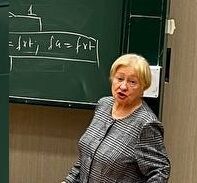150032 (732565), страница 2
Текст из файла (страница 2)

It is known that this equation can possess unstable solutions at small values of  and
and  .
.
Solutions to eqs. (7) can be found using iterative methods of slowly varying phases and amplitudes:
(10)  ;
;  ,
,
where  and
and  are new unknown coordinates.
are new unknown coordinates.
By substituting this into eqs. (9), we obtain the first-order approximation equations
(11)  ;
;  ,
,
where  is the coefficient of the parametric excitation;
is the coefficient of the parametric excitation;  is the generalized phase governed by the following differential equation
is the generalized phase governed by the following differential equation
 .
.
Equations (10) and (11), being of a Hamiltonian structure, possess the two evident first integrals
 and
and  ,
,
which allows one to integrate the system analytically. At  , there exist quasi-harmonic stationary solutions to eqs. (10), (11), as
, there exist quasi-harmonic stationary solutions to eqs. (10), (11), as
 ,
,
which forms the boundaries in the space of system parameters within the first zone of the parametric instability.
From the physical viewpoint, one can see that the parametric excitation of bending waves appears as a degenerated case of nonlinear wave interactions. It means that the study of resonant properties in nonlinear elastic systems is of primary importance to understand the nature of dynamical instability, even considering free nonlinear oscillations.
Normal forms
The linear subset of eqs. (0) describes a superposition of harmonic waves characterized by the dispersion relation
 ,
,
where  refer the
refer the  branches of the natural frequencies depending upon wave vectors
branches of the natural frequencies depending upon wave vectors  . The spectrum of the wave vectors and the eigenfrequencies can be both continuous and discrete one that finally depends upon the boundary and initial conditions of the problem. The normalization of the first order, through a special invertible linear transform
. The spectrum of the wave vectors and the eigenfrequencies can be both continuous and discrete one that finally depends upon the boundary and initial conditions of the problem. The normalization of the first order, through a special invertible linear transform

leads to the following linearly uncoupled equations
 ,
,
where the  matrix
matrix  is composed by
is composed by  -dimensional polarization eigenvectors
-dimensional polarization eigenvectors  defined by the characteristic equation
defined by the characteristic equation
 ;
;
 is the
is the  diagonal matrix of differential operators with eigenvalues
diagonal matrix of differential operators with eigenvalues  ;
;  and
and  are reverse matrices.
are reverse matrices.
The linearly uncoupled equations can be rewritten in an equivalent matrix form [5]
(12)  and
and  ,
,
using the complex variables  . Here
. Here  is the
is the  unity matrix. Here
unity matrix. Here  is the
is the  -dimensional vector of nonlinear terms analytical at the origin
-dimensional vector of nonlinear terms analytical at the origin  . So, this can be presented as a series in
. So, this can be presented as a series in  , i. e.
, i. e.
 ,
,
where  are the vectors of homogeneous polynomials of degree
are the vectors of homogeneous polynomials of degree  , e. g.
, e. g.

Here  and
and  are some given differential operators. Together with the system (12), we consider the corresponding linearized subset
are some given differential operators. Together with the system (12), we consider the corresponding linearized subset
(13)  and
and  ,
,
whose analytical solutions can be written immediately as a superposition of harmonic waves
 ,
,
where  are constant complex amplitudes;
are constant complex amplitudes;  is the number of normal waves of the
is the number of normal waves of the  -th type, so that
-th type, so that  (for instance, if the operator
(for instance, if the operator  is a polynomial, then
is a polynomial, then  , where
, where  is a scalar,
is a scalar,  is a constant vector,
is a constant vector,  is some differentiable function. For more detail see [6]).
is some differentiable function. For more detail see [6]).
A question is following. What is the difference between these two systems, or in other words, how the small nonlinearity is effective?
According to a method of normal forms (see for example [7,8]), we look for a solution to eqs. (12) in the form of a quasi-automorphism, i. e.
(14) 
where  denotes an unknown
denotes an unknown  -dimensional vector function, whose components
-dimensional vector function, whose components  can be represented as formal power series in
can be represented as formal power series in  , i. e. a quasi-bilinear form:
, i. e. a quasi-bilinear form:
(15)  ,
,
for example

where  and
and  are unknown coefficients which have to be determined.
are unknown coefficients which have to be determined.
By substituting the transform (14) into eqs. (12), we obtain the following partial differential equations to define  :
:
(16)  .
.
It is obvious that the eigenvalues of the operator  acting on the polynomial components of
acting on the polynomial components of  (i. e.
(i. e.  ) are the linear integer-valued combinational values of the operator
) are the linear integer-valued combinational values of the operator  given at various arguments of the wave vector
given at various arguments of the wave vector  .
.
In the lowest-order approximation in  eqs. (16) read
eqs. (16) read
 .
.
The polynomial components of  are associated with their eigenvalues
are associated with their eigenvalues  , i. e.
, i. e.  , where
, where

or  ,
,
while  in the lower-order approximation in
in the lower-order approximation in  .
.
So, if at least the one eigenvalue of  approaches zero, then the corresponding coefficient of the transform (15) tends to infinity. Otherwise, if
approaches zero, then the corresponding coefficient of the transform (15) tends to infinity. Otherwise, if  , then
, then  represents the lowest term of a formal expansion in
represents the lowest term of a formal expansion in  .
.
Analogously, in the second-order approximation in  :
:

the eigenvalues of  can be written in the same manner, i. e.
can be written in the same manner, i. e.  , where
, where  , etc.
, etc.
By continuing the similar formal iterations one can define the transform (15). Thus, the sets (12) and (13), even in the absence of eigenvalues equal to zeroes, are associated with formally equivalent dynamical systems, since the function  can be a divergent function. If
can be a divergent function. If  is an analytical function, then these systems are analytically equivalent. Otherwise, if the eigenvalue
is an analytical function, then these systems are analytically equivalent. Otherwise, if the eigenvalue  in the
in the  -order approximation, then eqs. (12) cannot be simply reduced to eqs. (13), since the system (12) experiences a resonance.
-order approximation, then eqs. (12) cannot be simply reduced to eqs. (13), since the system (12) experiences a resonance.
For example, the most important 3-order resonances include
triple-wave resonant processes, when  and
and  ;
;
generation of the second harmonic, as  and
and  .
.
The most important 4-order resonant cases are the following:
four-wave resonant processes, when  ;
;  (interaction of two wave couples); or when
(interaction of two wave couples); or when  and
and  (break-up of the high-frequency mode into tree waves);
(break-up of the high-frequency mode into tree waves);
degenerated triple-wave resonant processes at  and
and  ;
;
generation of the third harmonic, as  and
and  .
.
These resonances are mainly characterized by the amplitude modulation, the depth of which increases as the phase detuning approaches to some constant (e. g. to zero, if consider 3-order resonances). The waves satisfying the phase matching conditions form the so-called resonant ensembles.
Finally, in the second-order approximation, the so-called “non-resonant" interactions always take place. The phase matching conditions read the following degenerated expressions
cross-interactions of a wave pair at  and
and  ;
;
self-action of a single wave as  and
and  .
.
Non-resonant coupling is characterized as a rule by a phase modulation.
The principal proposition of this section is following. If any nonlinear system (12) does not have any resonance, beginning from the order  up to the order
up to the order 
 , then the nonlinearity produces just small corrections to the linear field solutions. These corrections are of the same order that an amount of the nonlinearity up to times
, then the nonlinearity produces just small corrections to the linear field solutions. These corrections are of the same order that an amount of the nonlinearity up to times  .
.
To obtain a formal transform (15) in the resonant case, one should revise a structure of the set (13) by modifying its right-hand side:
(16)  ;
;  ,
,
where the nonlinear terms  . Here
. Here  are the uniform
are the uniform  -th order polynomials. These should consist of the resonant terms only. In this case the eqs. (16) are associated with the so-called normal forms.
-th order polynomials. These should consist of the resonant terms only. In this case the eqs. (16) are associated with the so-called normal forms.
Remarks
In practice the series  are usually truncated up to first - or second-order terms in
are usually truncated up to first - or second-order terms in  .
.
The theory of normal forms can be simply generalized in the case of the so-called essentially nonlinear systems, since the small parameter  can be omitted in the expressions (12) - (16) without changes in the main result. The operator
can be omitted in the expressions (12) - (16) without changes in the main result. The operator  can depend also upon the spatial variables
can depend also upon the spatial variables  .
.
Formally, the eigenvalues of operator  can be arbitrary complex numbers. This means that the resonances can be defined and classified even in appropriate nonlinear systems that should not be oscillatory one (e. g. in the case of evolution equations).
can be arbitrary complex numbers. This means that the resonances can be defined and classified even in appropriate nonlinear systems that should not be oscillatory one (e. g. in the case of evolution equations).
Resonance in multi-frequency systems
The resonance plays a principal role in the dynamical behavior of most physical systems. Intuitively, the resonance is associated with a particular case of a forced excitation of a linear oscillatory system. The excitation is accompanied with a more or less fast amplitude growth, as the natural frequency of the oscillatory system coincides with (or sufficiently close to) that of external harmonic force. In turn, in the case of the so-called parametric resonance one should refer to some kind of comparativeness between the natural frequency and the frequency of the parametric excitation. So that, the resonances can be simply classified, according to the above outlined scheme, by their order, beginning from the number first  , if include in consideration both linear and nonlinear, oscillatory and non-oscillatory dynamical systems.
, if include in consideration both linear and nonlinear, oscillatory and non-oscillatory dynamical systems.
For a broad class of mechanical systems with stationary boundary conditions, a mathematical definition of the resonance follows from consideration of the average functions
(17)  , as
, as  ,
,
where  are the complex constants related to the linearized solution of the evolution equations (13);
are the complex constants related to the linearized solution of the evolution equations (13);  denotes the whole spatial volume occupied by the system. If the function
denotes the whole spatial volume occupied by the system. If the function  has a jump at some given eigen values of
has a jump at some given eigen values of  and
and  , then the system should be classified as resonant one5. It is obvious that we confirm the main result of the theory of normal forms. The resonance takes place provided the phase matching conditions
, then the system should be classified as resonant one5. It is obvious that we confirm the main result of the theory of normal forms. The resonance takes place provided the phase matching conditions
 and
and  .
.
are satisfied. Here  is a number of resonantly interacting quasi-harmonic waves;
is a number of resonantly interacting quasi-harmonic waves;  are some integer numbers
are some integer numbers  ;
;  and
and  are small detuning parameters. Example 1. Consider linear transverse oscillations of a thin beam subject to small forced and parametric excitations according to the following governing equation
are small detuning parameters. Example 1. Consider linear transverse oscillations of a thin beam subject to small forced and parametric excitations according to the following governing equation
 ,
,
















